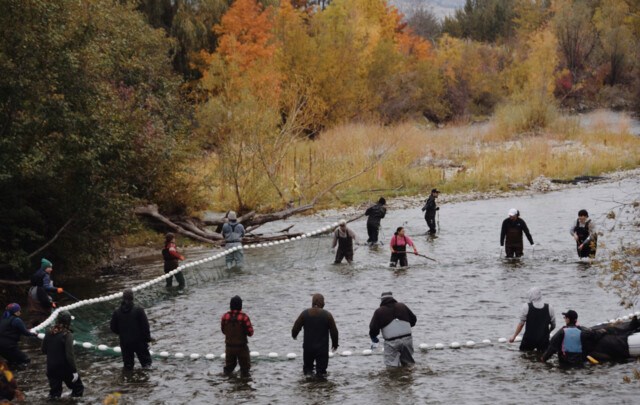After a decade of hard work at the fish hatchery and more than two decades from the Okanagan Nation Alliance restoration project, the Valley is expected to see a record return this year for sockeye.
As of Tuesday, the ONA team is estimating upwards of 300,000 fish making it into the Okanagan River to spawn.
“It's safe to say that we are just overwhelmed with fish this year, which is great news to hear,” Hatchery Biologist Tyson Marsel said.
“Everyone around the ONA, the word is heartwarming, where you actually have numbers coming back, where you can see the success.”
Crews have been working down the river in Oliver, collecting broodstock for the hatchery located on Penticton Indian Band land.
Salmon are sorted by gender and quality, then loaded into bags and floated down the river into larger tanks which would bring them up to the hatchery for fertilization.
On Tuesday, staff were on their eighth day of collecting eggs from mature fish.
Marsel said he expects to be collecting right to the end of October.
“Currently, we are at just over 2.5 million eggs at the facility, and all that credit goes to our hard-working crews,” he added. “We have a goal to reach about 5 million eggs that we're going to take into the facility this year.”
The fish will be raised until they reach around one gram in size, and then they are released into the Okanagan system.
“There are multiple different tributaries that hold great spawning habitat where those fish used to spawn, but due to [a] blockage with the dam, they weren't able to make it there for a number of years,” Marsel said.
The hatchery work began in the late 1990s as an experimental reintroduction into Skaha Lake, since there were no salmon upstream of McIntyre dam.
The long-term program aims to restore the historical range of sockeye in the upper Okanagan watershed, Okanagan Lake, and Skaha Lake systems — part of the Columbia River Basin.
The reintroduction officially got underway in 2004, with the team increasing the number of hatchery fry they raise.
In the past five years, the Sockeye have had partial access to Okanagan Lake and in the past two years, full access.
“This year is really exciting, having a good return coming up because we're actually seeing those adults from four years ago making their way into the Okanagan Lake system and spawning in all those tributaries.”
Each year, sockeye and chinook salmon make their journey from the ocean all the way up into the Okanagan River system. Hatchery teams get a first look at salmon return numbers when they swim past Bonneville Dam, the first dam at the bottom of the Columbia River.
This year, Marsel said Bonneville Dam saw well over 700,000 fish pass over, and well over 400,000 that passed a dam just below the confluence of the Okanagan River.
The return was later than usual, as the warm fall temperatures kept the fish back from moving from the glacier waters of the Columbia River to the warmer Okanagan River.
“It was a major, major thermal barrier that was set. It was strictly set with no fish movement. And we were waiting and waiting,” Marsel said.
“There's always the worries of if they're actually going to make it up all this way with all the fishing going on down there, and all the climate change environmental conditions they have to face for them to actually be making it to the system.”
But make it they did, with some salmon heading all the way up to Mission Creek in Kelowna.
“It's just super exciting to see that what we're doing is working. These fish are homing into where we're releasing them, and they're spawning in the habitat where we release them. So everything we're doing is working and reintroducing that population.”
Marsel said as a conservation facility, the motto and end goal is to work themselves out of a job.
“We want to have a wild, sustainable population where we do not need this hatchery impact, where our hatchery fish are getting put into the system. We want a completely wild, sustainable run over the four-year cycle,” he said.
“We just got to keep up our hard work, and hopefully one day we'll be able to see those days where you can walk across the backs of the salmon in the river like it used to be.”
Seeing such a strong return year gives the group confidence their work has an impact.
“We have multiple different teams, all our habitat crews, all our biologists out in the field doing all the work in stream assessments and water quality management,” Marsel said.
“All those little steps are the important piece of the puzzle. The hatchery here, where we're the ones putting the fish into the system, is just a small piece of that puzzle.
“So actually looking after the water and having that data and that availability to tell what's happening in the system is going to allow us to actually grow our numbers, not just from the hatchery-wise, but also helping out that wild population where we have an active work crew always out wondering and seeing what the water and what the environment is doing.”
While full numbers won’t be finalized until later on, Marsel said it's impressive to be, also a record-breaking year.
“It's exciting to see such large numbers making it into the river to spawn.”



